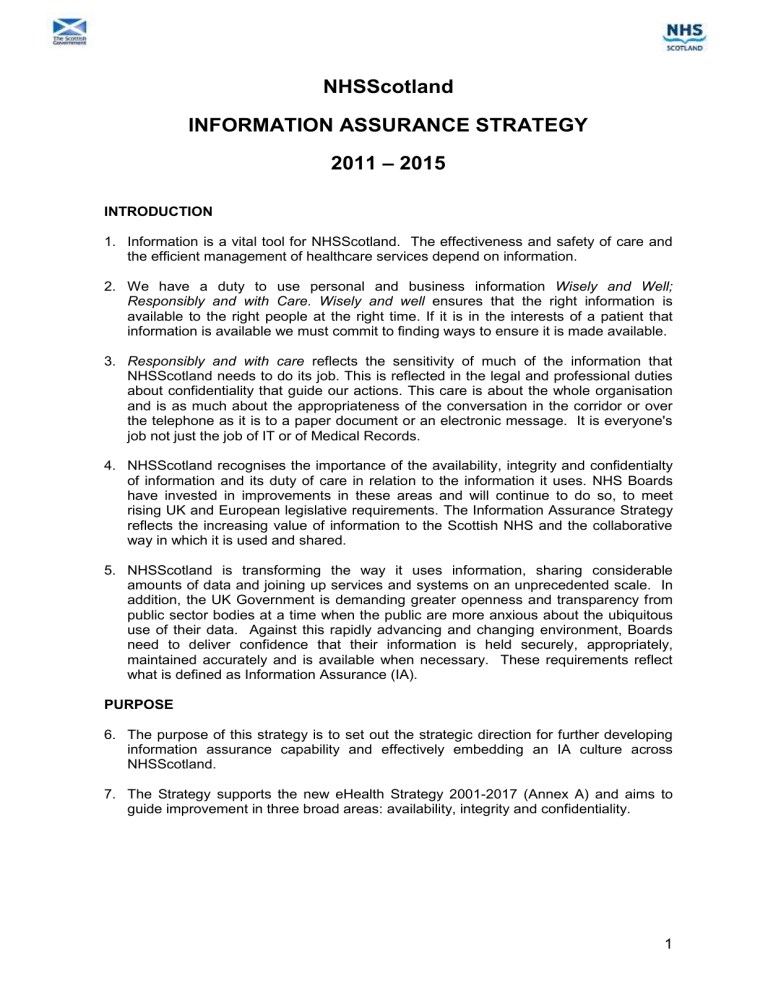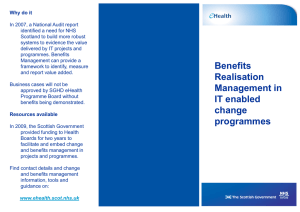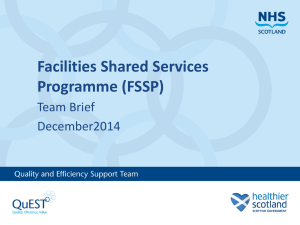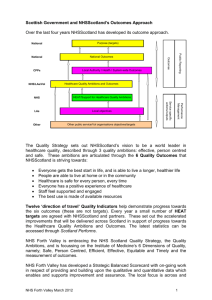Policies and procedures

NHSScotland
INFORMATION ASSURANCE STRATEGY
2011 – 2015
INTRODUCTION
1. Information is a vital tool for NHSScotland. The effectiveness and safety of care and the efficient management of healthcare services depend on information.
2. We have a duty to use personal and business information Wisely and Well;
Responsibly and with Care.
Wisely and well ensures that the right information is available to the right people at the right time. If it is in the interests of a patient that information is available we must commit to finding ways to ensure it is made available.
3. Responsibly and with care reflects the sensitivity of much of the information that
NHSScotland needs to do its job. This is reflected in the legal and professional duties about confidentiality that guide our actions. This care is about the whole organisation and is as much about the appropriateness of the conversation in the corridor or over the telephone as it is to a paper document or an electronic message. It is everyone's job not just the job of IT or of Medical Records.
4. NHSScotland recognises the importance of the availability, integrity and confidentialty of information and its duty of care in relation to the information it uses. NHS Boards have invested in improvements in these areas and will continue to do so, to meet rising UK and European legislative requirements. The Information Assurance Strategy reflects the increasing value of information to the Scottish NHS and the collaborative way in which it is used and shared.
5. NHSScotland is transforming the way it uses information, sharing considerable amounts of data and joining up services and systems on an unprecedented scale. In addition, the UK Government is demanding greater openness and transparency from public sector bodies at a time when the public are more anxious about the ubiquitous use of their data. Against this rapidly advancing and changing environment, Boards need to deliver confidence that their information is held securely, appropriately, maintained accurately and is available when necessary. These requirements reflect what is defined as Information Assurance (IA).
PURPOSE
6. The purpose of this strategy is to set out the strategic direction for further developing information assurance capability and effectively embedding an IA culture across
NHSScotland.
7. The Strategy supports the new eHealth Strategy 2001-2017 (Annex A) and aims to guide improvement in three broad areas: availability, integrity and confidentiality.
1
Information Assurance
Confidentiality :
We protect information from unauthorised disclosure and ensure that we only hold information that we need and have a right to retain
Integrity:
We ensure that the data we hold is correct, current, & can only be modified by authorised users with clear audit trails
Availability:
We ensure that the data needed is there when its needed
Board Governance of IA
Clear lines of accountability
& roles and responsibilities
Awareness & Education of all employees
Codes of Practice: confidentiality , Health records management, HR,
IG & acceptable use policies
Information sharing protocols
Fair processing
Privacy impact assessment
Identity & access management
Development & implementation of Clinical & Administrative systems & workflows
Data Quality
Classification of Information & application of applicable security controls
System Audit & monitoring
Software & hardware-based solutions to protect information systems
Corporate records management
Development & implementation of Clinical & Administrative systems & workflows
Risk Management
Business continuity
Incident reporting & response procedures
Service & operational level agreements. DR plans and wider IA activity are clearly articulated
Technical system performance.
IT operational environment maintenance
FOISA Compliance procedures
This Information Assurance strategy sets out a coherent approach to managing information by making it an integral and effective part of normal business processes.
VISION
That the NHS in Scotland gets the best out if its information, moves forward and develops its use, confident that the risks associated with collecting, holding, using and sharing information are well managed. NHSScotland arrangements carry the trust and confidence of both patients and NHSS employees.
PRINCIPLES
NHSScotland believes that accurate, timely and relevant information is essential to deliver the highest quality healthcare. As such, it is the responsibility of all NHS employees to ensure and promote the quality of information and to actively use information in decision making processes.
NHSScotland aims to strike a balance between principles of corporate governance and public accountability, placing importance on confidentiality and security arrangements to safeguard both personal and business information.
NHSScotland recognises the need to share patient information internally and across NHS
Board and with key partners in a controlled manner consistent with the interests of the individual and, in some circumstances, the public interest.
2
STRATEGIC ACTION
The following four areas are consistently 1,2 seen as key to delivering successful information assurance:
1. Leadership and Governance
2. Information Risk Management
3. Policy and Operations
4. Monitoring and Compliance.
The table below illustrates the key areas of activity:
Key Areas and elements for Success in Information Assurance
Leadership &
Governance
Information Risk
Management
Policy & Operations Monitoring &
Compliance
Human
Factors
Policy
/Practices
Strategy, Vision
& Direction
Clear lines of accountability
Information to public e.g. HRIS
Clear & Robust methods for communicating & enforcing policies
& procedures
Board governance of IA
Incident reporting
Classification of
Information & application of applicable security controls
Information Risk
Management
Disaster Recovery
Business Continuity
Privacy Impact
Assessment
Awareness &
Education of all staff
Structure, Roles,
Responsibilities
Skills & expertise
Business Continuity
Identity & access management
HR, IG & Acceptable
Use policies
Service & operational level agreements
DR plans & wider IA activity are clearly articulated within contracts with suppliers.
Technology Key strand of IT strategy
IT security risk assessment
System Audit & monitoring
Software & hardwarebased solutions - to protect information systems
IT infrastructure maturity model
IT operational environment maintenance (virus & malware protection)
The actions under each area where delivery can be strengthened are:
Internal &
External Audit
Statement of
Internal
Controls
IG walk rounds
IG standards
Breach detection & reporting
IG toolkit
Verification &
Testing
1 Information Assurance Maturity Model: CESG
2 The Coleman Report: Independent Review of Government Information Assurance: June 2008
3
1. Leadership and Governance
Outcomes: Information assurance responsibilities are assigned from the Board downwards to ensure information as a business asset is balanced with other business drivers at every level of the organisation.
Information Assurance will be understood , visible and accessible to all NHSS employees and will be embedded in the culture of NHSScotland both nationally and locally, aligned across NHSS Boundaries.
Clearly defined and understood roles and responsibilities in which appropriately skilled staff are held accountable for their decisions and actions. Individuals recognise the relevance of information assurance to them and their own responsibilities. Information assurance is seen as an enabler and an integral part of NHS operations, rather than a restriction.
Actions:
Boards to review local arrangements to ensure clearly articulated lines of responsibility and accountability for both clinical and business information.
Simplify the number of IG forums. Establish an SG supported Information
Assurance Forum to develop co-ordinated joint working, sharing best practice and establishing information assurance priorities across the NHSS.
2. Information Risk Management (IRM)
Outcomes: A proportionate risk management approach embedded in the organisation.
Information risk managed throughout the Board in a structured way for clear understanding of risks, threats, vulnerabilities and impact on the business. The risk management framework will be aligned to the Boards corporate risk management framework.
Identify, manage, action and learn from the risk experiences of other NHS organisations.
Assess risk continuously and be aware of up and coming risks.
Actions:
Commission a review of current Board risk management mechanisms, identifying best practice and make recommendations. Profile is raised to CEO and Audit
Committee level.
3. Policy and Operations
Outcomes: Requirements/minimum acceptable standards, are articulated to employees and supply chain partners through clear polices based on best practice standards. The standards will be clear, well communicated and readily available.
IA standards, policies and processes continue to evolve to remain current with NHSS national and local objectives and priorities.
A range of IA control measures are implemented in a cost effective way to reduce the vulnerability of information systems to compromise throughout their life cycle.
4
Deal with incidents in a way that reduces the business impact, including:
putting in place service and operational level agreements for all business critical services.
embedding security policies and procedures into national and local delivery contracts with suppliers.
having access to technology that is affordable, secure and reliable. Have reusable solutions that are built on ‘best of breed’ and where others already have experience of their effective use.
Access to personal and business information is correctly managed and safeguarded including creation, storage, transmission and destruction.
Key personnel have the knowledge and experience to be able to build, design and deliver information assurance at local level and with key stakeholders.
Actions:
Continue to support Health Rights Information Scotland to develop and publish awareness material for the public relating to eHealth, confidentialty and access to health records.
Commission the production of core NHSScotland information assurance foundation level educational material. Boards to consider using Cabinet Office online training modules as interim measure.
Work with Human Resources to review key documentation including the data protection/confidentialty statements in employee contracts and information retention policies.
Support further training for appropriate staff in the following areas: investigations, forensic readiness and risk management & Privacy Impact Assessment.
Work with NHS Boards to develop an information classification scheme reflecting the breadth of the information processed by NHSScotland that aligns with key partners such as Police and Local Authorities and enables the application of appropriate security controls.
Work collaboratively to simplify, standardise and document working practices required to support the shared services agenda.
Acquire and implement specialist Single Sign On software to better manage user identity and system access.
Acquire and implement privacy breach protection software to enable NHS Boards to strengthen their existing privacy surveillance and breach detection capabilities.
4. Monitoring and Compliance
Outcome: Effective compliance mechanisms provide positive assurance that Board policy is being implemented in an effective way to achieve the desired outcomes.
Actions:
Review of the current IG standards and toolkit and their fit with board level compliance IA activity.
5
Annex A
CONTRIBUTION OF INFORMATION ASSURANCE TO THE NEW EHEALTH STRATEGY
eHealth Strategy Objectives How does Information Assurance contribute to eHealth Strategy?
1. Maximise efficient working practices, minimise wasteful variation, bring about measurable savings and ensure value for money
2. Support people to communicate with the
NHSS, manage their own health and wellbeing, and to become more active participants in the care and services they receive
3. Contribute to care integration, and to support people with long term conditions
IA is not solely about compliance; there is also a strong efficiency element to it; e.g. cost avoidance through continuity planning, avoiding duplication of processes, improving data quality brings clinical benefits as well as increased security.
Raising awareness of eHealth and the benefits it can bring. Individuals will make greater use of technology if they are confident that the mechanisms used to share data are safe and secure.
Greater utilisation of new digital methods for self-management (e.g. social media via broadband); and that if used in a secure and controlled manner they can empower patients for example online appointment bookings which are cheaper than traditional methods.
Information Assurance enables data sharing to take place regardless of physical boundaries based on the data protection and Caldicott principles.
4. Improve the availability of appropriate information for healthcare workers 3 and the tools to use and communicate that information effectively to improve quality
5. Improve the safety of people taking medicines and their effective use
Making the right information available to the right people at the right time irrespective of physical boundaries and taking into account the data protection and
Caldicott principles.
3 The World Health Organisation defines a healthcare worker as anyone whose focus or activity is to improve health. The definition includes doctors, nurses, midwives as well as technicians and managers.
6
Annex B
Area key to success
Areas identified by Boards for focused improvement activity
Leadership/
Governance
Information risk management
Acknowledgement that strong visible leadership at board level is essential. However, others also have a role to play such as the Caldicott Guardian custodian of patient identifiable data or Information Asset Owner (Staff with service based responsibility for information assets.)
Skilled and competent IG practitioners 4 are essential to providing assurance to CEO`s.
Greater collaboration between IG practitioners, infrastructure and eHealth leads to drive forward IA agenda at local and national level.
Greater focus needs to be placed on the approach to identification, reporting and management of risks and sharing collective learning from incidents.
Training,
Education and
Awareness –
Public
NHSS INFORMATION ASSURANCE CURRENT AND PROPOSED IMPROVEMENT ACTIVITY
Important to raise public awareness of development and benefits of eHealth. Health Rights Information Scotland public information leaflets were seen as a valuable vehicle for promoting a consistent public message.
Current national improvement activity
NHSS Caldicott Guardian Forum established to facilitate the legitimate sharing of the patient identifiable information intra NHSScotland and with key partners.
SG continues to support the IG
Practitioners through the provision of specific guidance e.g. NHSScotland
Caldicott Guardian Manual and new website.
SGHD commissioned Health Rights
Information Scotland to develop a leaflet and short animated clip outlining the eHealth agenda. This work is complete.
Proposed future improvement activity
Boards to review local arrangements to ensure there are clearly articulated lines of responsibility and accountability for both clinical and business information .
Establish an SG supported Information Assurance
Forum to develop co-ordinated joint working, for sharing best practice and establishing Information assurance priorities across the NHSS.
Boards to ensure robust risk management frameworks in place, which feed into service plans and the development of appropriate controls.
Profile is raised to CEO and Audit Committee level.
It is recommended that the Strategy Board supports further discussion with CEO`s regarding the mechanisms for central incident reporting.
Existing wider activity seen as sufficient.
4 Information Governance Practitioner includes: Caldicott Guardian, Data Protection Officers, Information Governance Managers, IT Security Officers, Health
Records & Freedom of Information Leads
7
Area key to success
Training,
Education and
Awareness
Areas identified by Boards for focused improvement activity
Beyond the Board it was recognised that every member of staff has a personal responsibility to adhere to their professional codes of conduct and/or practice in respect of good information management including participation in information governance training relevant to their job role.
Future work should challenge ‘custom and practice‘. This could be achieved by NHS specific package which:
clearly articulate NHS expectations
reads across to existing material such as
NHSScotland Code of Practice on Confidentiality.
case study based and capable of being delivered in a range of formats.
dovetailed with the existing mandatory learning packages for junior medical and nursing staff.
capable of being used by Higher Education
Institutions, to influence practice from the outset.
Continue to extend NHS Board staff skills in the following areas:
investigations
forensic readiness
risk management & Privacy Impact Assessment
Enhance skills of Band 2 AfC Health Records staff.
Current national improvement activity
Approaches currently vary across
Boards depending on the resources available. A small number of Boards have purchased commercial generic online packages, however their content and success is unknown.
SG has commissioned NES to develop core NHSScotland information assurance foundation level educational material. This work is now underway and is anticipated to be complete by Nov 2011
A revised Code of Practice on
Confidentiality is in the final stages of preparation.
NHS Education Scotland has completed work to extent the existing
IA material within DOTS. It will be launched in August 2011.
NHSS IG Team have facilitated training days held for risk management & Privacy Impact
Assessment (PIA).
The certificate of technical competence training programme for health records staff is currently being rolled out across NHS Boards.
Proposed future improvement activity
Boards to consider using Cabinet Office online training modules as interim measure.
SG will continue to work with NES & key stakeholders to review and update the IA material within “Flying Start”.
It is recommended that Strategy Board supports further training for appropriate staff in the following areas: investigations, forensic readiness and risk management & Privacy Impact Assessment.
8
Area key to success
Policy and
Operations
Areas identified by Boards for focused improvement activity
Current national improvement activity
Proposed future improvement activity
Policies and procedures :
Consensus that the SG produces clear and concise core policy independently of the implementation (local boards have own which are compatible with the national one)
Policies and procedures should:
align with professional bodies codes of practice and guidance
explicitly state “rules of game”
greater collaboration internally with appropriate groups of staff e.g. HR
Divided opinion on NHSScotland wide core policies and procedures. If this route were to be pursued this should be done on a collaborative basis.
Acknowledgment that the ability to successfully apply sanctions against individuals depends on the robustness of board polices and procedures.
Boards have well established mechanisms in place to disseminate information about good information management and incidents.
Robust methodology in place to assess the business impact of access to information and apply the correct protection, handling and disclosure instructions.
Where possible, exploit ‘single sign-on’ mechanisms to support management of electronic access to information eHealth is currently reviewing and rationalising the department circulars relating to information governance.
Revised NHSS Records Management
Code of Practice and 7 practical guidance notes were published in
August 2010.
Work with Human Resources to review key documentation including the data protection/confidentialty statements in employee contracts and information retention policies.
Work programmes for Caldicott
Guardians, Data Protection Officers,
IT Security Officers and Health
Records Managers have been reestablished.
Work underway to utilise intelligence from the IAM programme to develop, standards, streamline and improve processes for staff identity and role management.
Consult on the development of core NHS “rules of the game”
Establish an IA Group who are commissioned to carry out discrete pieces of work to rationalise and harmonise board level policies and procedures within a given time frame.
NHS Boards may wish to consider utilising a policy compliance software to enhance current methods for communicating and enforcing policy at a local level.
Work with Boards to develop an NHSS wide information classification scheme which aligns with key partners such as Police and Local
Authority and enables the application of appropriate security controls.
9
Policy and
Operations
Monitoring &
Compliance
Infrastructure optimisation workshop to look at current IT infrastructure and operations
Developments in technology and communication technologies. Acknowledgement that employees and boards need to understand and respect the power, limitations and technical controls of mobile devices.
System Audit and monitoring :
General support for introduction of a software package which could assist with system audit of staff activity.
Acknowledged this was not “ silver bullet” but was a good deterrent.
Work to date had focused on traditional IG activity. Going forward need to review whether the current IG standards and toolkit remain fit for purpose and the extent to which they are embedded into local IA compliance activity.
SG is supporting an NHS Board led commission for the procurement of a single sign-on solution, on behalf of all NHS Boards.
Number of propriety areas for improvement identified by Boards.
Improvements plans developed by
Infrastructure Leads.
Work continues to develop an NHSS
Infrastructure strategy
Deliberations of implications of Web2 and “Cloud” underway.
SG is supporting an NHS Board led commission of a specialist tool to support audit log analysis, on behalf of all NHS Boards, building on the knowledge gained from those who already have purchased the tool.
Some Boards have introduced information governance walk rounds.
These were had been well received by operational staff, leading to changes in practice. eHealth is participating in the discussions with QIS and SG H&SC
Quality & Safety colleagues to develop an integrated, risk-based, proportionate approach to governance for NHSScotland.
Greater focus on simplifying, standardising and documenting working practices is required to support the shared services agenda.
Boards to review that Service level Agreements and Operating Level Agreements are established for all business critical services and that these include reference to archive, back up and restore process and recovery times
Expectation that the audit procured tool will be progressively implemented in tandem with associated people management.
NHS Boards to consider the introduction of a information governance walk rounds, involving other NHS Boards IG practitioners.
It is recommended that Strategy Board supports a review of the current IG standards and toolkit and their fit with board level compliance IA activity.
10






